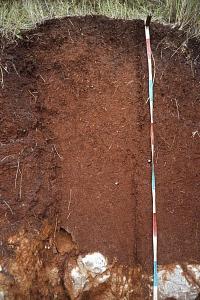Reference soil Italy 15: Luvisol
Luvisols occur mainly in temperate regions, particularly in areas with a Mediterranean-type of climate.
Characteristics
Soils having an argic horizon (a subsurface horizon with a distinct higher clay content than the overlying horizon) with a cation exchange capacity equal to or more than 24 cmolc per kg clay throughout.
Reference soil IT015: Luvisols
Dark reddish brown, clayey soil with angular blocky structure overlying, with an abrupt and irregular boundary, partly desintegrated dolomitic limestone. In the argic B horizon clay-iron(-humus) cutans (on pedfaces and as linings along pores) and common slickensides occur. Throughout the soil many fine, medium and coarse roots are found. PARENT MATERIAL: colour of the weathering limestone varies; weathering planes are red (2.5YR 4/8), C material is pink (7.5YR 7/4), rock is light grey (10YR 7/1). HUMAN INFLUENCE: frequent bush fires during the summer. ROCK OUTCROPS: at site no stones or rock outcrops, but nearby exceedingly stony and rocky. VEGETATION: dominant are Ampelodesma tenax link and Cytisus villosus. REFERENCES: Remmerzwaal A. 1978. Soil Genesis and Quarternary Landscape Development in the Tyrrhenian Coastal Area of South-Central Italy. University of Amsterdam. Fys. Geogr. en Bodemk. Lab. Publ. no. 28. Sevink J. et al. 1981. The Soils of Southern Lazio and Adjacent Campania (Agro Pontino, Volsci Range, Garigliano Basin, Valle Latina). Geologica Romana. See also references with profile IT009 (I9). PROFILE DESCRIPTION: Bt1: common small slickensides. Bt2: common small and medium slickensides. Bt3: common medium and large slickensides.
